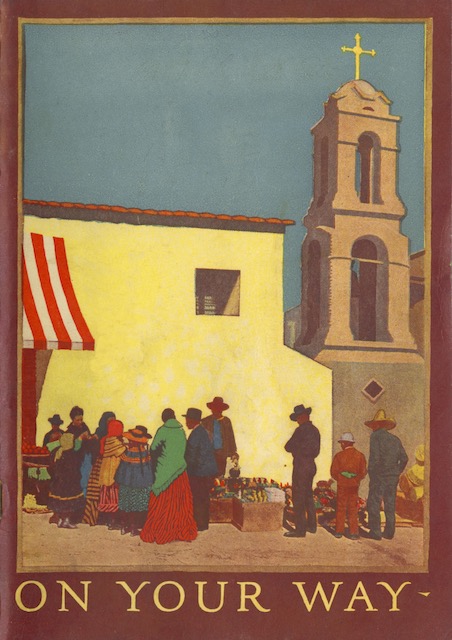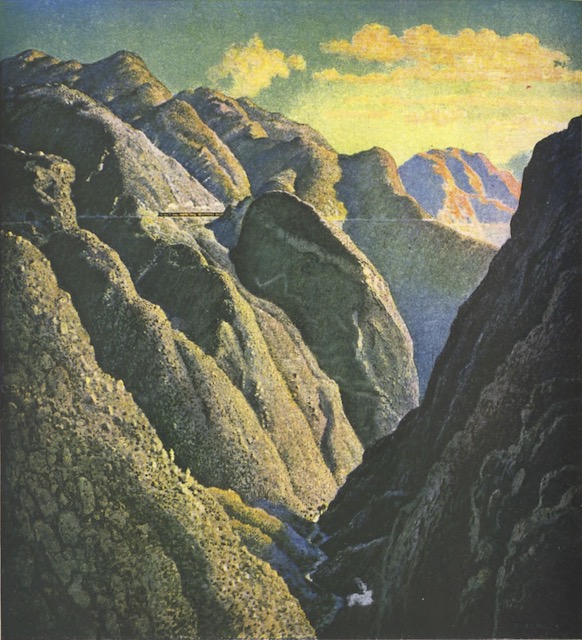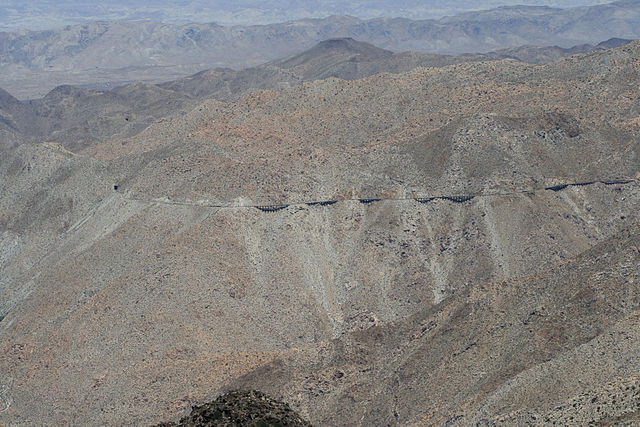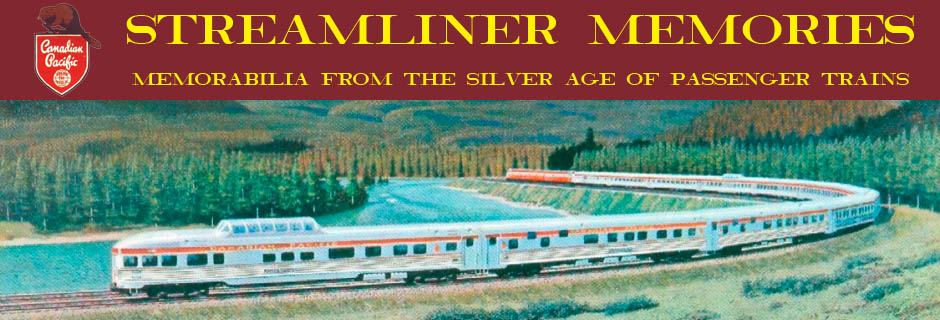“It takes no longer yet you see more” when you travel to California on the Golden State Limited, argues this post-war booklet issued by the Rock Island. While the booklet makes a lengthy argument for this claim, I consider it somewhat questionable.
 Click image to download a 15.5-MB PDF of this 68-page booklet.
Click image to download a 15.5-MB PDF of this 68-page booklet.
This booklet isn’t as gorgeous as Rock Island’s 1930 Garden of Allah, which I’ve called the most beautiful advertising booklet ever issued by any railroad, yet it is still quite sumptuous. For one thing, unlike the 9- to 10-point type typical of many advertising booklets of the 1920s and 1930s, this one mostly uses 14- or 15-point type, thus fitting no more than about 180 words per page.
The booklet has plenty of photos and drawings and a beautiful duotoned map in the centerfold with a photo of a Rock Island 4-8-2 locomotive pulling an eleven-car train. That locomotive, incidentally, was built in 1920, meaning it was just three years old when this booklet came out. With 74″ drivers and more than 50,000 pounds of tractive effort it was the latest word in passenger power.
At the same time, large print and black-and-white photos that are mostly of locations not actually visible from the Golden State route don’t make up for the fact that this route wasn’t really very scenically attractive. I never rode the Golden State, which stopped operating in 1968, but I rode the Sunset Limited, which followed the same route between El Paso and Los Angeles. In terms of scenic beauty, it falls far short of Santa Fe’s route over Raton Pass.
 Carriso Gorge as portrayed in this booklet.
Carriso Gorge as portrayed in this booklet.
In response to Santa Fe’s promotion of the Grand Canyon, this booklet emphasizes Carriso Gorge, which the painting on page 6 (shown above) suggests is just as impressive. In reality, as shown in the photo below, which was taken of the same scene from a different location, the gorge is dramatic but bleak compared with the colors of the Grand Canyon.
Update: Since I wrote this, I’ve learned that Carriso can sometimes enjoy a gorgeous “superbloom” of flowers in the spring. This only lasts a few weeks and isn’t portrayed in the painting, but it would have been spectacular to see from the train. Those who have a Macintosh with OS14 (Sonoma) can see a video of this superbloom, probably the one in 2023, as their screensaver.
 Carriso (now usually spelled Carrizo) as photographed in 2007 by Jim Epler.
Carriso (now usually spelled Carrizo) as photographed in 2007 by Jim Epler.
Carriso Gorge was not on the Golden State route, but on the separate San Diego and Arizona Railway. It opened in 1919, meaning Rock Island was right to promote it in 1923, but anyone taking the Golden State to Los Angeles would have to add several hours to their journey to take the Carriso Gorge detour. Visiting the Grand Canyon would also add time to a Santa Fe traveler’s trip, but some 1923 travelers might have been disappointed to realize that the only color image in this entire booklet portrayed a rail line that wasn’t part of the Golden State route.
Having to compete on the Chicago-Los Angeles route with four trains a day on the Santa Fe plus four trains a day (including a mail train) on the Union Pacific, the Golden State route’s three trains a day was always number three. Wikipedia says that Santa Fe’s California Limited carried almost twice as many passengers as the Golden State Limited, and I suspect UP’s Los Angeles Limited was between those two. Part of the reason, at least in 1923, would have been the inferior scenery on the Golden State route.
It wasn’t as if the Rock Island-Southern Pacific weren’t trying, at least in 1923. A meal in the dining car, the booklet promises, “can be very much like a meal in a quite exclusive club or fine hotel.” The train includes a library and a “beautifully appointed observation car.” In perhaps a deliberate reference to the opulent Santa Fe de-Luxe of a few years before, the booklet describes the Golden State Limited as a “de luxe train,” claiming that “when it comes to comfort and convenience the Golden State Limited is unlimited.”
The booklet is also honest when it says “It takes no longer.” In 1923, the Golden State took 68-1/2 hours between Chicago and Los Angeles, which was the same as the Los Angeles Limited and California Limited. At the time, no extra fares were charged for any of these three limited trains.
Perhaps because of its lower ridership, the Golden State lost this equality a decade later, when Santa Fe began running the Super Chief and Union Pacific the City of Los Angeles on 39-3/4-hour schedules. Initially, Rock Island and Southern Pacific failed to buy Diesels and lightweight passenger cars for this route, which meant they were unable to reduce the Golden State‘s schedule to much below 60 hours. When they replaced steam and heavyweights with Diesels and lightweight cars after the war, they reduced the times to 45 hours, but that was still a noticeable disadvantage.
So this booklet is a reminder of the comforts available aboard a typical 1920s train, a train you would take only if you lived in a city that wasn’t served by any other train or if you had taken trains on the other two routes and wanted to see what the third route was like.

SP actually ran a magazine ad sometime in the 1950s poking fun at the fact that long stretches of the Golden State and Sunset routes weren’t especially scenic. The ad went on to helpfully point out that a lot of this mileage was covered in darkness, so it really didn’t make a difference. That’s what you call “polishing a turd.”
Southern Pacific never really viewed its Golden State as competing with the Super Chief, or even the City of Los Angeles. It viewed the Chief as its rival, even to the point of scheduling the Golden State’s departure time from Chicago to match that of the Chief. This lasted from around 1948 until 1954, when Santa Fe added coaches to the Chief while at the same time speeding up its schedule to 39-3/4 hours, which SP could not match due to their unwillingness to install upgraded signaling equipment on the El Paso – Santa Rosa line.